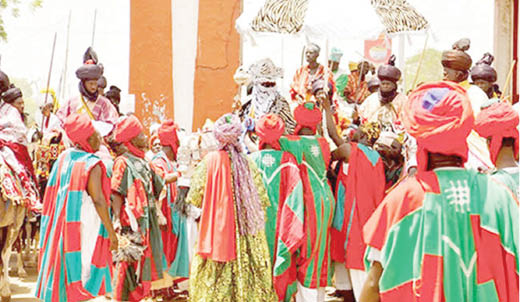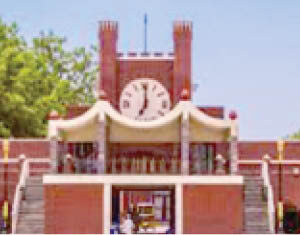In the ancient city of Kano, there are critical monuments, places and events that defined not only the state but also the country; unfortunately, they are no longer operational or in existence, making younger generations to lose history. They are also deprived of the opportunity to understand the relevance of such monuments and their benefits to the society.
Most of these critical monuments lack sufficient documentation and preservation despite several calls to do so. Without proper documentation of such monuments, they risk being forgotten completely. Below are some of the monuments.
SPONSOR AD
Kano famous pyramid
For many decades, Kano State has been a home for agricultural produce. Records have shown that due to its ability to gather agricultural produce for exportation through the then effective rail lines, the state became synonymous with groundnut pyramids that served as its symbol. The groundnut pyramids were pyramid-like structures made from groundnut sacks. The groundnuts were said to have been grown in Kano and other places.
History has it that groundnut production was a strong pillar in the country’s economy during the colonial era and during the First Republic, as well as a key source of income to the businessmen of the colony and colonial masters.
In those years, these pyramids served as tourists’ attraction, as well as a symbol of northern Nigeria’s wealth and economic strength. Till today, Kano prides itself as a city with groundnut pyramids (Birni mai dalar gyda)
According to history, the pyramids were said to have been invented by a famous businessman in the region, Alhassan Dantata. He was one of the most successful businessmen that ever existed in the region. He was supplying the Royal Niger Company (RNC) groundnut and other agricultural commodities. It was gathered that the pyramids were created as a form of storage methodology, where bags of groundnut were stacked in the shape of a pyramid before they were taken by train to Lagos and shipped out of the country.
Unfortunately, the vast land space that served as the centre for the famous pyramids is no more, as over the years, the pyramids disappeared gradually without explanation.
At the initial stage, the site of the pyramids became an open field with no single presence of the pyramids. The site remained like that till few years ago when structures began to emerge on the open field. This development has put to an end, the hope that the pyramids would return.
The site, popularly known as ‘Filin Holo’ is now something else. Perhaps the younger generation may only get to know what the site held if they care to read the history of the ancient city of Kano.
The ancient city wall
The Kano ancient wall, known as ‘Badalar’ Kano,’ has been to every true Kano resident a source of pride and joy, just like the Great Walls of China is to a typical Chinese. The people of the state have tried to preserve the walls through various means possible despite facing huge and serious challenges of encroachment.
To preserve their history, the people of the state adopted a form of song that dares every boy and girl to memorise the names of the ancient city’s nine wall gates. This song has become like a societal anthem that seeks to preserve the historic works of the people of the state and also to preserve their historic monuments amidst modernity and structural developments.
According to a Kano-based historian, Malam Idris Bashir, the city wall was usually built in the ancient times to avert foreign invasion into the city and prevent internal rebellion. He said the walls were built to serve as a protective shield from enemies within and outside the city, as well as serve as a barrier to weaken attacks, be it external or internal.
The historian said the ancient wall of Kano was built in the 12th century during the reign of Emir Gijimasu between 1095 and 1134. He added that the city was expanded during the reign of Emir Muhammadu Rumfa, who moved the emir’s palace to its present location.
He further said the city wall was built to serve as a form of point of business control by screening goods and services entering the city. He added that according to history, the ancient wall of Kano had some entrances or gates, and each of the gates was manned by a loyal subject of the emir, called ‘Sarkin Kofa.’
Each Sarkin Kofa served as the custodian of the gate assigned to him. His house, as well as that of the small army attached to him, was situated close to the gate.
The ancient wall of Kano was a point of call for tourists for many decades, but unfortunately, the city walls are now being replaced by residential buildings, fuel stations, mega plazas and other architectural structures. This act, according to many people, signifies a demise of a heritage of the people despite federal government’s declaration of the city wall as a national monument.
Similarly, in a report by the Gidan Makama Museum that serves as the custodian of the walls and associated sites in Kano, people officially or unofficially pulled down the ancient wall to build structures. The report indicated that for this and other practices against the wall, the museum officials declared that out of 100 per cent Kano city wall, less than 25 per cent are standing today, while over 70 per cent are gone without structural trace.
As time goes on, the younger generation will only get to know the existence of the ancient city wall through pictures, literature or verbal narration as destruction towards the remaining less than 25 per cent continues, although authorities in the state had maintained the majority of the gates.
According to the curator of the National Museum, Kano, Rose Madaki, it is very important for every nation to preserve its heritage. She noted that the Kano Gidan Makama and the city walls had been declared as national monuments. She explained that though most parts of the walls were gone, the present state government is considering rebuilding part of it, a move she said the national museum would be happy to be part of.
Kano durbar
For every true Nigerian from Kano, durbar had always been a major event he or she looked forward to being part of. It was a common sight to witness when thousands of indigenes and non-indigenes of Kano gathered during a specific occasion irrespective of religion or political affiliation, just to witness the durbar.
Durbar festival had been a traditional event, cultural display and expression in northern Nigeria for many decades. This cultural festivity had been in practice and cherished by not only the people of Kano State but also the global community as tourists from far always to be part of it.
Durbar was said to have been introduced by Emir Muhammadu Rumfa in the late 15th century as a way of demonstrating military power and skills before going to war. Over time, the practice became a ceremonial festival associated with eids, welcoming of visiting important dignitaries, as well as installation of new emirs.
Durbar now serves as a form of entertainment, instructing, exciting and dignifying the emirate’s traditional heritage and the state’s traditional structure.
Over the years, the festival also developed into a prominent cultural industry as thousands of artisans look forward to making a living through breeding of horses, manufacturing of saddles, ceremonial garments and musical instruments. The durbar became well known as a leading festival that attracts cultural tourism in not only Kano State but the entire North and the country in general.
Sadly, recently, the decades-long practice suffered a major setback due to issues related to insecurity and politics by some authorities. It was gathered that some years back, the state didn’t witness durbar celebration, and when they did, it was with some modifications that completely changed the traditional pattern.
According to a Kano-based historian, Ahmad Ibraheem Dawaki, the way things are going now, durbar in Kano State has lost the thrills and booms it used to give to the people. The number of tourists visiting the state for the durbar has reduced drastically. Perhaps it would be cancelled completely due to political intrigues.
“Every year, people look forward to a very colourful durbar. They respect and cherish the thrills durbar usually comes with, but unfortunately, in the last few years, insecurity and political happenings in the state have completely tampered with the decades-old event. People no longer wait in anticipation as the whole process has been altered due to circumstances. Our fear is that the aged-long event may be cancelled completely,” he said.
Mamuda WAPA
Many people know WAPA as a business area popular for currency exchange known as Bureau De Change. Only few knew that WAPA is not just a name of a business place but also a name of an individual who set a business pattern that is still operating not only in Kano but also across the country.
Mamuda Dantata is one of the sons of the famous Kano business tycoon, Alhaji Alhassan Dantata. He was a wealthy merchant who was also one of the few pioneers that set up investments in tourism, hotel, currency trading, sugar mill and petrol stations from the North. In 1950, he started exploring ways to transport pilgrims by road through Sudan to Saudi Arabia for Hajj. It was gathered that his name came from the company he established – he was the founder of the West African Pilgrimage Agency (WAPA).
According to Alhaji Isah Wudil, a 76-year-old businessman, what is known today as WAPA was a bushy and filthy area. He explained that history has it that Alhaji Mamuda WAPA reclaimed the land and cleared it to become inhabitable and later built WAPA house, which later became known for currency trading.
“We were told that Alhaji Mamuda WAPA was a businessman and politician who represented Kano east on the platform of the Northern People’s Congress (NPC). And he was one of the few businessmen that embraced modern business initiatives. It was also reported that he was the initiator of an independent travelling agency in the northern part of the country,” Wudil said.
Wudil further said it was sad that the young ones may not know that WAPA is not just a business structure but the name of an individual who had contributed to the development of Kano as a business hub and as a pioneer of a business investments that are still thriving.
Kundila
No doubt, Kano has been a trading and important commercial centre in the history of Nigeria. The state has produced quite a number of wealthy individuals whose names will always be in the books of history. However, some of these wealthy individuals have been forgotten, not because their names have weathered away but because they have become synonymous to monumental structures. Many people are aware of the housing estate known as Kundila but only few knew that it is the name of a wealthy individual in Kano.
The late Alhaji Haruna Kundila was known for his great wealth and fortune in the pre-colonial Kano during the reign of Emir Abdullahi Maje Karofi and his successor, Emir Bello Ibrahim Dabo.
He was so rich that people believed he could afford anything he wanted. There was this popular Hausa saying attributed to him: Bana siyarwa bane ya gagari Kundila, literally meaning that there is nothing Kundila can’t afford to buy unless it is not for sale, because of his massive wealth and purchasing power.
History has it that in his heydays, there was no one in Kano with Kundila’s wealth. He was very rich and had estates by each of the city gates. It was said that he owned more than 1,000 slaves. In fact, he was the wealthiest trader in the 19th century Kano. But today, Kundila is only the name of a housing estate. Many people did not know that it is a name of a wealthy person who had given the ancient Kano something to be proud of.
520-year-old dyeing pit
Another monument going extinct is the popular and historic 520-year-old Kano dyeing pit situated in the ancient Kofar Mata area. The historical site is currently in a state of disarray as the business and the dyeing centre faces extinction despite its history and symbolic role in the state’s history.
According to the secretary-general of the Kano dyeing centre, Haruna Baffa, Kofar Mata pits were established in 1498 by Muhammadu Dabosa, who came to settle in Kano from Rimaye in the present day Katsina State. He added that history revealed that besides being a farmer, Dabosa began dyeing cloths as a family craft. And since then, the family has been running the dyeing business.
The Kofar Mata dyeing pit is one of the historical monuments in Kano State. The centre is said to have served as a first port of call to national and international guests and tourists who visited Kano State on either official or personal engagements.
However, it was reliably gathered that while the centre serves tourism purposes, it is said to have received less attention from the authorities in the state.
Malam Musa Zango, a practitioner, said the centre was at a time producing the best fabrics in the state, adding that with the intrusion of the Chinese into the dyeing business, thousands of youths involved in it across the state were rendered jobless. The Chinese were allowed to import cheap qualities of finished fabrics into Nigeria, usually made from plastic fabrics instead of cotton; and that has crippled activities at the pit. Sources within the state’s History and Culture Bureau told our correspondent that the state government is fully aware of what happened to the centre and there are plans to revive it soon.
One of the practitioners at the centre, Isma’ila Kofar Mata, said it was sad that with the way things are going, the centre would soon exist only in some literatures because many people have changed their trade.
“As you can see, the dyeing centre with over 144 pits is almost deserted because many of us have changed the trade. No matter how proud you are with your art, there are bills you must pay; and currently, dyeing is going instinct. As time goes on, the young ones won’t know what local dyeing was and their heritage will be forgotten,” he said.



